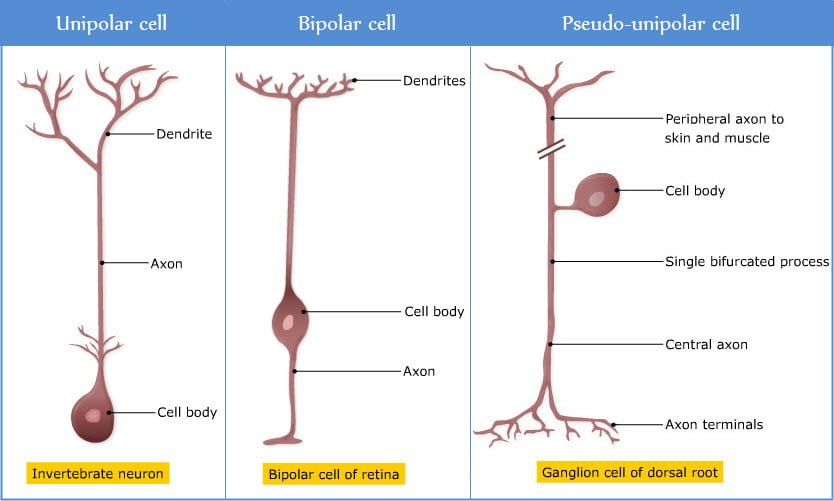TABLE OF CONTENTS
Classification of neurons
Anatomical classification
According to the number of processes that arise during embryological development. All developing neuroblast pass the stages where processes are formed.

Apolar neuron
There are no processes present in apolar types of neurons.
Unipolar neuron
They have a simple processes developing from soma. This process may split into two, one conveys towards the cell body and other conveys away from cell body. Hence they are referred to as pseudounipoloar neuron.
Pseudounipolar neuron
A typical bipolar neuron. Develop as bipolar neuron but as it develops they fuse to form one process. Sensory in nature. Pseudo unipolar cells are “T” shaped cells whose peripheral branch is physiologically a dendrite but serve as axon to conduct nerve impulse centrally. Located in the ganglia outside the CNS.
Bipolar neuron
These are the neurons are spindle shaped with axon at one pole and dendrite at the other pole. These are the neurons with the two processes emerging from opposite sides of the soma. Commonly seen in vertebrate retina to transmit light impulses to retinal ganglion cells, as well as olfactory neuroepitthelium. One of the two main processes extending from the cell body, is highly branched & conveys information to the cell body, similar to the function of dendrite.
Multipolar neuron
These have many cellular processes extending from the cell body. One of these is an axon, and other constitutes highly branched dendrites. Most commonly seen in vertebrates, in cerebellar cortex (purkinje cells), motor coterx ( pyramidal cells) and ventral horn of the spinal cord.
There are two types of mutipolar neuron. Classified depending upon the length of the axon.
- Motor nerve cell: cells with long axon. E.g. neurons in the ventral grey column of spinal cord. Axons of these cells arise from the CNS to become peripheral motor nerve fiber.
- Type II Golgi cell: cell with short axons. The axon divides into many branches in the area of cell body. Because of this arrangement sensory neurons are placed in contact with motor neurons. Hence they are known as internerurons or internuncial neurons. They lie within the CNS. They remain between afferent and efferent neurons. For more complicated actions more interneurons are involved.
Functional classification

Sensory or afferent (towards/ carrying)
Information from sensors to CNS intimating CNS of external environment (sensory stimuli) and provides status reports on internal activities (visceral) that are regulated the nervous system.
Internuncial neurons
remain in CNS act as a relay between two neurons.
Motor or efferent ( from/ exit)
instructions from CNS to the effector organs to provide appropriate action.
- This outflow is by two means
- Somatic nervous system– to skeletal muscles. Fibers of motor neurons that supply skeletal muscles.
- Autonomic nervous system – using sympathetic and parasympathetic divisions control the effector organ such as smooth muscle, cardiac muscles and glands.